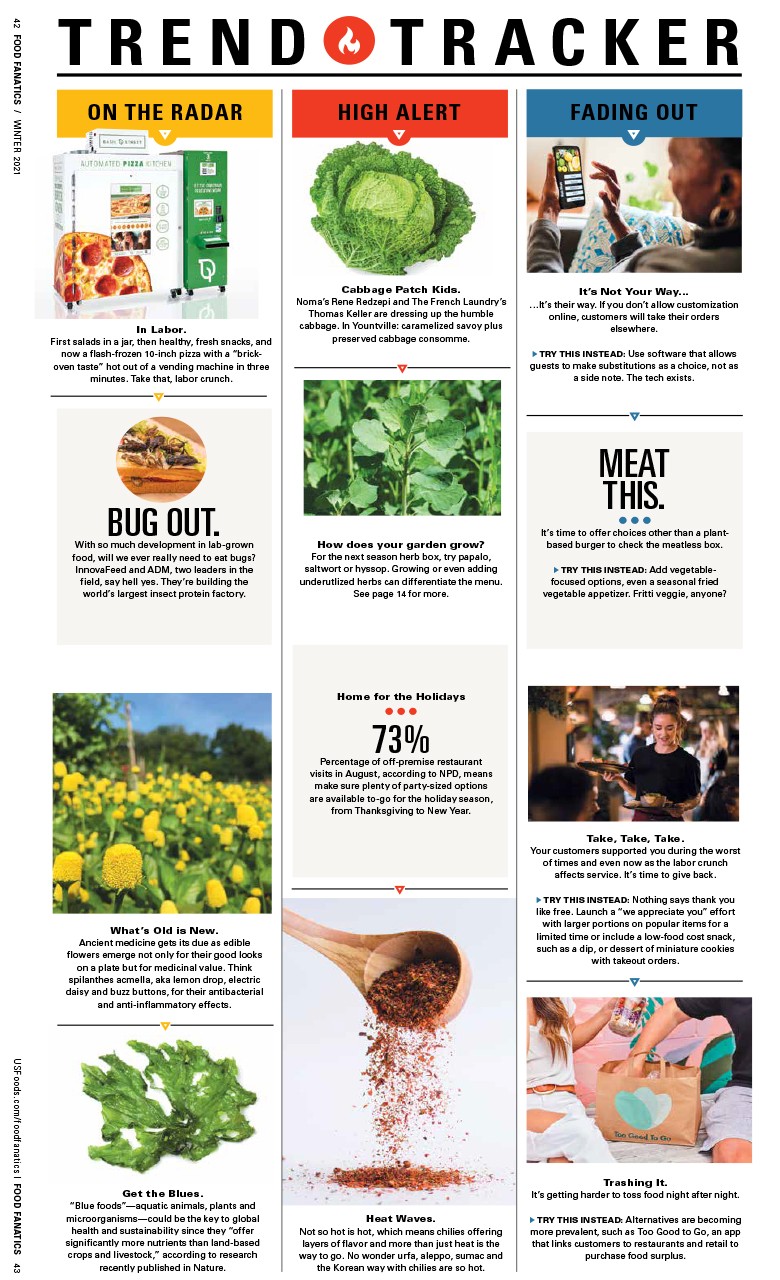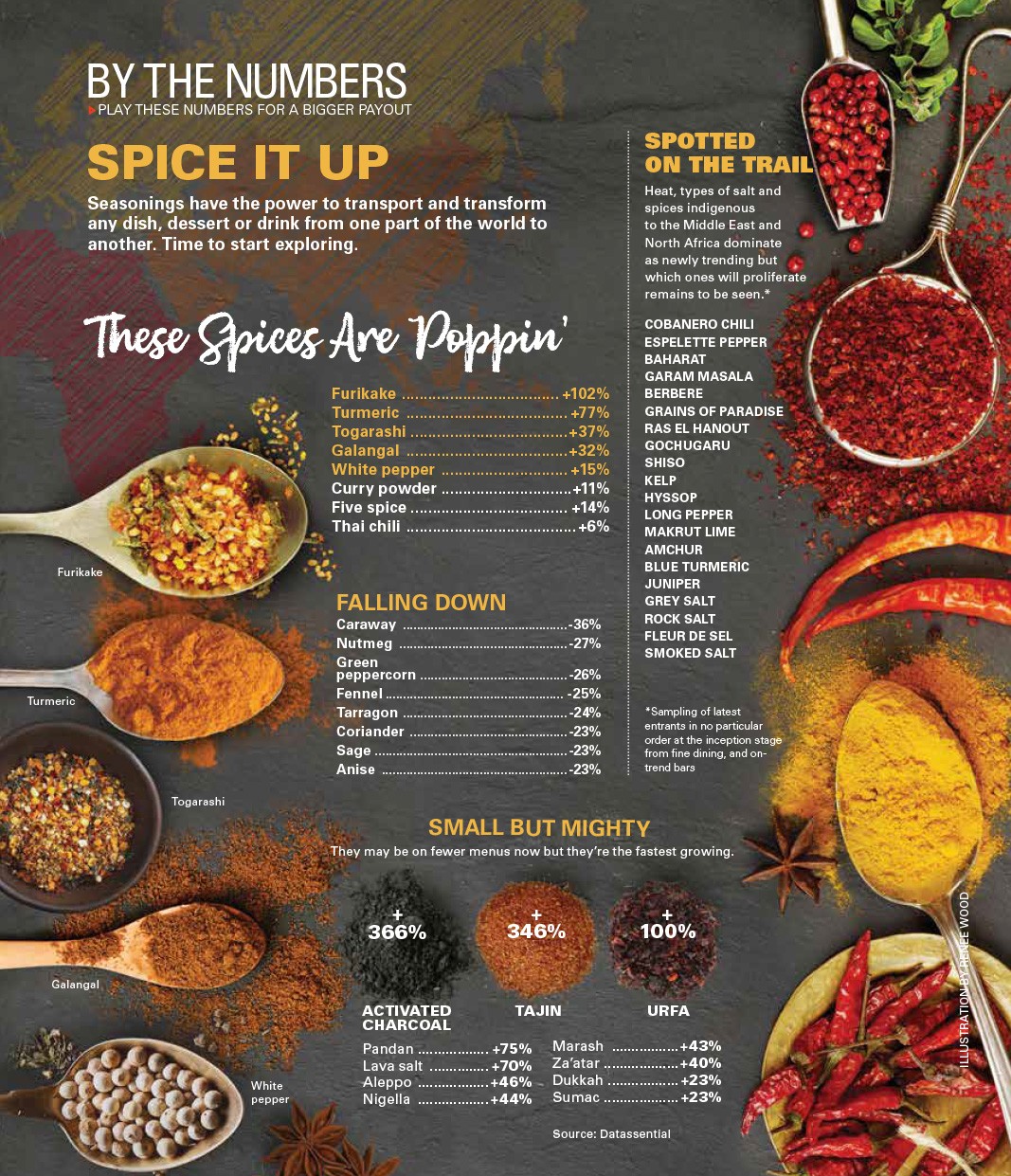SOUPS ON: HOW TO COOK UP SUCCESS THAT SIMMERS
Soup is a fixture on many menus, and with good reason: the profit margin.
By using the odds, ends, bits and pieces from other dishes otherwise headed for the dumpster, soup often has the lowest food cost on the menu. “That’s the idea behind soups and stews,” says Shaun VanAlphen, chef of The Bonnie in New York City. “It’s all about the products that you normally wouldn’t use: the meat that’s too tough, the cod bones.”
But at a restaurant that’s keeping up with the trends, the soup “needs to find the balance between rich and creamy textures and flavors, yet still have a light and healthful feel,” says Laurent Tourondel, chef-owner of L’Amico and The Vine in New York City.
And that’s in line with the moment soup is having across the country. More substantial soups are hitting the marks. The varieties showing growth include bisques, gumbo and a few creamy types, such as crab and mushroom, according to market research firm Datassential. Gone are the divisions between the thin, brothy offerings on the appetizers side of the menu and the hearty, chunky stews found under entrées.
“People are looking for something comforting and warming,” Tourondel says.
Waste Not, Want Not
Soups, which are typically associated with lower food costs when leftover ingredients are included, allow chefs to be creative and work with seasonal ingredients across all segments and every cuisine.
And, as Tourondel points out, those low margins don’t just benefit the restaurant. “Soups are a low-cost item for both the restaurant and the diner,” he says.
Jason Vincent, who opened Giant in Chicago earlier this year, gets props for taking the lead on soup’s trendiness and economic benefits. Almost everything, including bread and cheese, is made in-house. Such an approach makes for a lot of byproducts for soup. Vincent’s favorite is whey, which he has in abundance as a byproduct from making fresh ricotta.
Whey is “the key to any winter soup,” Vincent says. This season, he’s pairing the whey with tomatoes and turning it into a broth, which he’ll slip in whey-tenderized brisket.
Hearty Doesn’t Mean Heavy
In the same city as Giant, David Chapman, chef de cuisine at Green Zebra, refuses to think of soup as an afterthought. “We put our best foot forward when we make soups,” he says.
The ethos of Green Zebra is vegetarian and “to keep things a little lighter,” Chapman notes. The restaurant’s offerings live in that middle space between light soup and heavy stew.
When Chapman decided to put a tomato rasam soup on the menu, he made a few tweaks to one of the classic Southern Indian dishes. “Traditionally, it’s served as a light broth with some spices in it,” he says. But for the Green Zebra version, he uses lentils to give the soup more substance in two ways. First, he grinds dried lentils and adds the pulverized legumes to his spice mix. When stirred into the broth, the lentil powder serves as an earthy thickening agent. Second, just before serving, Chapman adds a generous scoop of lentils, turning the dish into a more substantive meal.
This approach works both ways. With heavier bowls like potato soup, Chapman lightens things up. He eschews cream for his sweet potato soup, instead finishing it with black bean relish and bright tomatillo salsa. “It was heartier, but I was still keeping things light and fresh at the same time,” he says.
And his tactics are working. “We do sell quite a bit of soup,” he admits. ”Even hot soups in the summer.”
Good for the Bottom Line
Many restaurants offer more than one soup, bucking the old-school trend of touting just one at a time.
In fact, soups sell so well at Green Zebra – and the margins are so favorable (usually 20%, as opposed to the restaurant’s 25% average) – that two soups are always on the menu.
Soup has a regular spot at L’Amico, but Tourondel also features it as a special, allowing it to accommodate current inventory. Case in point: Zuppa Toscana, a traditional Tuscan soup featuring fennel sausage, cannellini beans, Tuscan kale and potato, often thickened with bread from the previous day.
But Tourondel keeps these soups extra special by pairing each one with focaccia or warm, just-baked pizza crust from the wood-burning oven.
Yet despite soup’s reputation as a big seller – especially the creamy variety – it caused VanAlphen some angst as he was gearing up to open The Bonnie. The chef usually leans on vegetables for his soups, noting that the approach satisfies vegetarians, but also keeps soups at his preferred 14% food cost, compared to the restaurant’s overall 22%. “Vegetables are really cheap, and you’re not using a large amount of product, so vegetarian soups are a pretty low cost for a restaurant,” he says.
But after living in Maine, he developed a love for seafood chowder. A classic version, though, would lead to a higher food cost and a rich and heavy soup.
The solution? He cuts the flour and butter, and uses puréed squash to thicken his base of clam and shrimp stock. A garnish of fresh seafood is situated in the center of the bowl with pickled squash to round out the richness. “In the end, it’s a hearty soup that won’t make you want to fall asleep,” he says. The food cost came in higher at 20%, but still a couple of points below the average.
“With such a huge focus on vegetables these days, we as chefs are thinking even more creatively about using ingredients to produce the best results at the best possible price points,” VanAlphen says.



